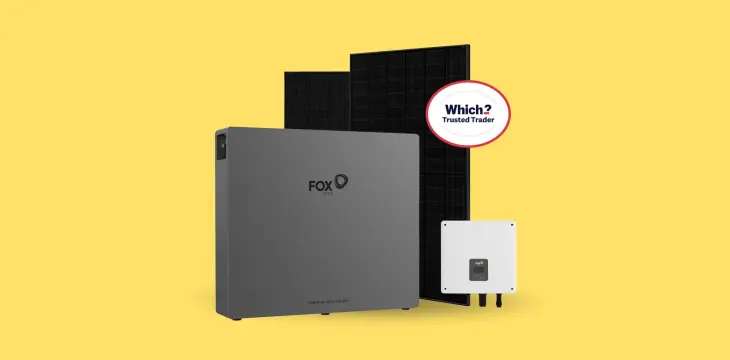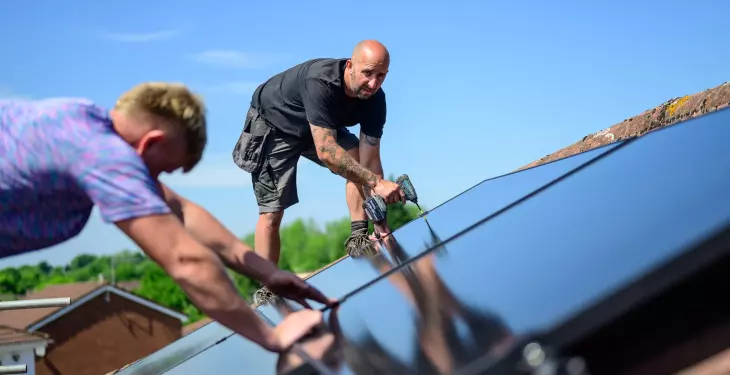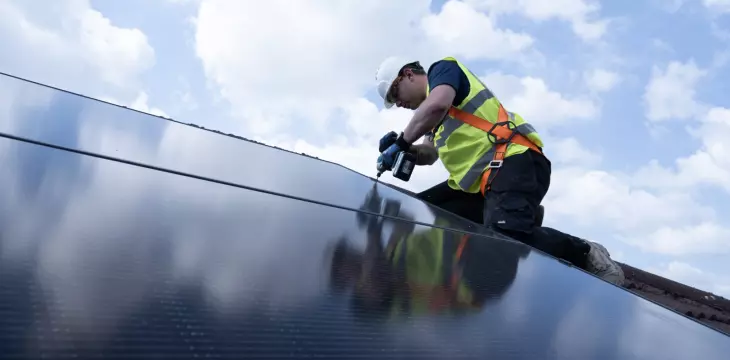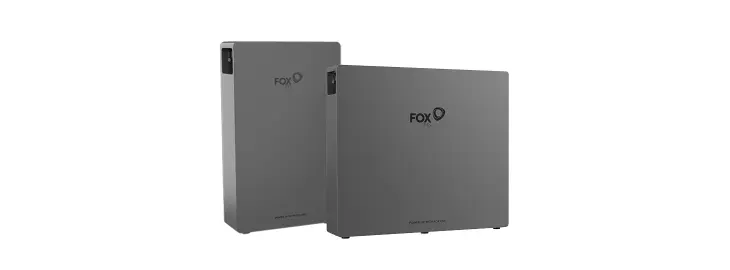

Written by Bethany Armstrong
Renewables Manager
Updated: 20th October, 2025
This guide explains the efficiency metrics that matter, compares high-efficiency panel options for UK homes, and shows how to pair panels with quality inverters and batteries for real-world results.
See how much you could save with a solar & battery quote.
Choosing the most efficient solar panels in 2025 comes down to matching module efficiency with your roof space, shading, and budget.
This guide explains the efficiency metrics that matter, compares high-efficiency panel options for UK homes, and shows how to pair panels with quality inverters and batteries for real-world results. It reflects systems iHeat installs, including high-efficiency Aiko panels with Fox ESS and Tesla storage.
Quick comparison table: most efficient options for UK homes
These picks focus on efficiency per square metre, real-world UK performance, and aesthetics. Prices are typical installed ranges for guidance, not quotes.
Pick | What it is | Typical panel wattage | Module efficiency | Look | Warranty (product / performance) | Ideal for | Typical installed price (no battery) |
Best overall efficiency | Aiko N-type all-black | 420–460 W | ~21–23% | Deep black | 25 yrs / up to 30 yrs | Most UK roofs that want top output per m² | £6,500–£9,500 for ~4–5 kW |
Best for small roofs | Premium high-efficiency N-type | 440–460 W | ~22%+ | All-black | 25 yrs / up to 30 yrs | Limited space where every tile counts | £6,800–£9,800 for ~4–5 kW |
Best value high-efficiency | Reliable N-type TOPCon | 410–435 W | ~21% | Black frame or all-black | 20–25 yrs / 25–30 yrs | Balanced spec and price with strong output | £6,000–£9,000 for ~4–5 kW |
Best low-light efficiency | Half-cut, multi-busbar N-type | 400–440 W | ~20–22% | All-black | 20–25 yrs / 25–30 yrs | Chimneys, trees, mixed aspects | £6,200–£9,200 for ~4–5 kW |
Tip: if your CMS prefers plain text tables, paste the same columns into your editor and convert to a table using tabs as the separator.
Module efficiency is the percentage of sunlight a panel turns into electricity. In 2025, high-efficiency residential panels typically sit around 21 to 23%. Efficient panels produce more power per square metre, which is perfect for roofs with limited space or complex shapes. The trade-off is cost. A small uplift in efficiency often carries a premium per panel, so you should check whether that premium helps you reach your target system size or would be better spent on a battery or better inverter.
Wattage per panel goes hand in hand with efficiency. Most UK-ready high-efficiency modules fall between 420 and 460 W. A 10-panel array of 450 W modules is about 4.5 kWp. If you only have space for 10 panels, a move from 410 W to 450 W increases total capacity by 10%, which is often worth it.
Temperature coefficient matters for summer performance. A smaller negative number, such as around −0.30%/°C, means less output drop as panels warm. The UK’s cooler climate helps efficient panels hold their advantage across the year.
Degradation is the slow loss of output over time. Premium N-type panels typically have low first-year loss and a gentle long-term curve, which preserves your efficient array’s yield.
Measure clear, shade-free rectangles where panels can sit. Count around vents, chimneys and velux windows. Efficient panels provide more kW within the same footprint, which may be the difference between a 3.6 kWp and a 4.5 kWp array.
Small or complex roofs: push for higher module efficiency to reach your target capacity.
Larger roofs: consider value high-efficiency panels to keep £/kW sensible while maintaining a neat all-black look.
Shade reduces output regardless of efficiency. Half-cut cells and modern busbar layouts help, but design is key. East-west arrays can deliver a broader generation curve that improves self-use of your efficient panels.
Efficiency makes the headline, but long warranties and proven installer support keep the system performing. Look for 25-year product and long performance coverage, plus clear documentation at handover.
Pair efficient modules with a quality hybrid inverter and plan for battery storage. Efficient arrays pair naturally with storage because they produce more surplus midday energy that can be shifted to the evening.
Why they stand out
Aiko’s high-efficiency N-type cell design drives excellent output per square metre, supported by a crisp all-black aesthetic and long warranties. UK roofs benefit from steady low-light performance and a temperature coefficient that keeps summer yields strong. For most homes that want maximum performance within a smart layout, Aiko is the benchmark.
Pros
High power density for tight roofs
Steady low-light behaviour through UK seasons
Deep black finish and tidy frames
Long product and performance warranties
Cons
Premium price bracket versus entry options
Ideal user
Homeowners who want maximum production per square metre, a refined look, and long warranties, with plans to add storage now or later.
Estimated system pricing
Around £6,500 to £9,500 for a 4 to 5 kW high-efficiency array, roof and hardware dependent.
Add £3,000 to £6,000 for battery storage depending on capacity.
You can explore high-efficiency system options on the iHeat solar page.
Why it stands out
If you are space-limited, higher wattage per panel can be the only way to reach your target kW. Fewer panels for the same capacity yields a cleaner layout, fewer roof penetrations, and a better match to hybrid inverters.
Pros
Highest yield per square metre
Can elevate a design from 3.5 to 4.5 kWp on the same roof
All-black options preserve kerb appeal
Cons
Higher cost per panel
Availability can vary at peak times
Ideal user
Terraced homes, dormers, and roofs broken up by chimneys or hips where every tile counts.
Estimated system pricing
Typically £6,800 to £9,800 for 4 to 5 kW, depending on layout and hardware.
Why it stands out
Modern N-type TOPCon panels offer high efficiency at a sensible price. For larger roofs, these modules can deliver an excellent £/kW while keeping the all-black look most homeowners prefer.
Pros
Strong efficiency at a balanced price
Good temperature coefficients and build quality
Black frame or full black options
Cons
Slightly lower power density than the very highest-end modules
Aesthetic uniformity can vary by model
Ideal user
Homes with enough roof area to reach their target capacity without paying the highest premium for per-panel wattage.
Estimated system pricing
Often £6,000 to £9,000 for 4 to 5 kW, roof and component choices dependent.
Why it stands out
Half-cut cells reduce the impact of partial shading by splitting current paths. Combined with multi-busbar layouts, these panels can hold output better on winter mornings and in real-world UK shade lines.
Pros
Better yield where shade is unavoidable
Solid efficiency and long warranties
Works well with hybrid inverters that manage uneven strings
Cons
Shade still reduces output; design is your first tool
May need more string design work to balance faces
Ideal user
Roofs with chimneys, nearby trees, or multiple orientations where shade is expected.
Estimated system pricing
Generally £6,200 to £9,200 for 4 to 5 kW, depending on layout complexity.
Example 1: small roof, 12 m² usable
With 410 W panels you may fit 8 modules: 3.28 kWp.
With 450 W high-efficiency panels you may fit the same 8 modules: 3.60 kWp.
That is a 9.8% bump in array size with no extra roof space or scaffolding time. If your goal is to run appliances through the day and cut evening imports with a modest battery, this uplift helps.
Example 2: larger roof, 24 m² usable
With 410 W panels you might fit 16 modules: 6.56 kWp.
With 450 W panels you might still choose 16 modules: 7.20 kWp, or you might decide the extra cost is better spent on 8 to 12 kWh of storage to increase self-use.
The right answer depends on your usage pattern and tariff, not only panel efficiency.
Orientation matters
A 4.5 kWp south roof will produce more annual kWh than the same array split east-west, but east-west spreads generation across the day and can increase self-use with or without a battery. Efficient panels help both layouts; the best design matches your routine.
Efficient panels need a quality inverter to convert DC power into usable AC and to manage batteries neatly.
Hybrid inverters keep your system compact and battery-ready.
Fox ESS hybrid inverters integrate neatly with modular Fox ESS batteries and provide clear monitoring for generation, storage level, and imports.
If you start solar-only, choose a battery-ready design so you can add storage later without rework.
Make sure your monitoring app is easy to understand. It helps you build habits that increase self-consumption from your efficient array.
Efficient arrays often produce more midday surplus. A battery shifts that energy to your peak times.
Fox ESS modular storage lets you start with a small stack and expand as needs grow.
Tesla Powerwall suits homes that prefer a larger single unit and an intuitive app experience.
Batteries also pair well with time-of-use tariffs, charging off-peak and discharging at peak to shorten payback.
If budget is tight, begin solar-only with a hybrid inverter so adding storage later is straightforward.
Simple capacity guide
5–7 kWh: flats or low use homes with efficient appliances.
8–12 kWh: typical semis and small detached homes, good day-evening coverage.
13–15+ kWh: larger homes, EV charging, or high evening loads.
Actual solar panel cost can depend on roof, access, hardware, and region, but these bands help planning.
High-efficiency solar only, 4–5 kW: often £6,000 to £9,500 installed.
Add battery storage: typically +£3,000 to £6,000, size and brand dependent.
Premium aesthetic options: expect a modest uplift for full-black frames, concealed rails, and roof-specific brackets.
Access and roofing: slate, three-storey scaffolds, or awkward rear access can add cost and time.
Grid notifications: your installer will handle DNO notifications and export applications. Timelines vary by region.
Maintenance: visual checks, occasional cleaning if soiled or under trees, and standard electrical checks as advised.
A design matched to your roof and usage can outperform a higher spec list on paper.
Check current solar panel grants and schemes before you buy to see if you can reduce the upfront cost
Home and usage | Typical system size | Panels (approx.) | Roof area needed | Annual generation guide | Notes |
1-2 bed flat or terrace, low use | 2–3 kW | 5–8 | 9–15 m² | 1,800–2,700 kWh | Efficient panels help reach 3 kW on small spaces |
2-3 bed semi, average use | 3.5–4.5 kW | 9–12 | 16–23 m² | 3,000–4,200 kWh | Most common UK fit; battery recommended |
3-4 bed detached, higher use | 5–6 kW | 12–15 | 23–30 m² | 4,200–5,600 kWh | Covers appliances and EV top-ups in shoulder months |
Large home or EV focus | 6.5–8 kW | 15–18 | 30–36 m² | 5,600–7,200 kWh | Best with a larger battery and tariff optimisation |
Generation ranges assume a reasonably south-facing aspect with limited shade. East-west still works very well and spreads generation across the day.
Orientation and tilt
South maximises annual kWh.
East-west spreads output into mornings and evenings which can increase self-use.
Typical roof pitches 30 to 45 degrees are ideal. Flat roofs work with low-profile mounts.
Shading
Map seasonal shade. Winter sun is low and creates long shadow lines.
Use stringing that keeps roof faces balanced. Consider module-level optimisation where it adds value.
Mounting and weathering
Use quality anchors, rails, and flashing to protect tiles and keep things watertight.
Slate requires specialist brackets and care. Flat roofs use ballast or low-pitch mounts to resist wind uplift.
Permissions and grid notifications
Most domestic installs fall under permitted development. Flats, conservation areas and listed buildings can be different, so check first.
Your installer manages DNO notifications and export approvals.
You will see two main warranties for panels.
Product warranty: covers the panel itself, ideally 25 years on premium modules.
Performance warranty: guarantees a percentage of original output after a set time, commonly around 88–90% at year 30 for premium panels.
Keep documentation safe: layout plan, serials, commissioning sheets, inverter details, and DNO confirmations.
Design first. Put panel efficiency to work by fitting the right number of modules in the right places with tidy strings.
Use all-black modules if appearance matters. Panels are a long-term fixture and will be seen every day.
Check temperature coefficient and degradation. These influence yield more than you might expect.
Pick a hybrid inverter that fits your future plan for batteries or EV charging.
Budget for scaffolding and access. Safe access protects your home and the team.
Think in kWh, not only kWp. Your bill savings depend on energy you use on site. Monitoring and simple habit changes finish the job.
Plan storage if evening usage is high. Batteries shift midday solar to your peak times.
Keep paperwork tidy. Warranties and DNO approvals matter later.
Choose proven aftercare. Strong installer support matters as much as hardware.
Panels: Aiko high-efficiency, 440 to 460 W, all-black
Inverter: Hybrid, battery-ready
Battery: Add later once usage is clear
Why it works: Highest output per square metre, clean layout, smooth path to storage
Panels: N-type TOPCon, 410 to 435 W
Inverter: Fox ESS hybrid
Battery: Modular Fox ESS stack, starter size
Why it works: Great £/kW, efficient array, flexible storage, clear monitoring
Panels: Aiko all-black high-efficiency
Inverter + battery: Tesla Powerwall based setup
Why it works: Premium look, large single battery, intuitive app and detailed insights
If your priority is the most efficient solar panels for a UK home in 2025, Aiko N-type all-black modules are a superb choice for most roofs. They deliver high power density, steady UK performance, and long warranties in a refined package. For small roofs, pushing toward 440–460 W panels can unlock system sizes that would not be possible otherwise. For larger roofs, value high-efficiency N-type TOPCon modules keep £/kW sensible without sacrificing looks.
Remember that efficiency is part of a system. The best results come from a design that matches your roof and routine, a quality hybrid inverter, and storage sized to your evening use. Get those fundamentals right and your efficient array will perform year after year, in real UK weather, on a real UK roof.
Last updated: 20th October, 2025

Written by Bethany Armstrong
Renewables Manager at iHeat
Bethany Armstrong is a renewables expert and operations manager at iHeat, specialising in heat pump solutions and solar project delivery across the UK.
LinkedInArticles by Bethany Armstrong are reviewed by iHeat’s technical team to ensure accuracy and reliability.

19th November, 2025
Most UK homes take one to two days for solar panel installation, with the full process fro...
 Read Article
Read Article

14th November, 2025
In this guide we compare key panel types and specs for UK homes, outline typical installed...
 Read Article
Read Article

14th November, 2025
Your ideal solar battery size depends on your energy use and solar setup. This guide cover...
 Read Article
Read Article
No obligation. Takes less than 60 seconds.